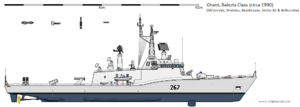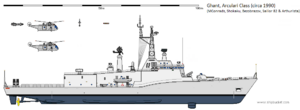Model 68 Common Destroyer: Difference between revisions
Arthurista (talk | contribs) |
Arthurista (talk | contribs) |
||
| Line 88: | Line 88: | ||
The Tusker air defence system lies at the heart of the Balezta. It features a SL-12 single-armed missile launcher, linked to a 42-round rotating magazine below-deck. The single-armed design was chosen over the original twin-armed proposals for increased reliability in hostile arctic conditions, and it has a relatively high rate of fire at 10 rounds per minute. The Tusker missile was originally a beam-riding design in its prototype stage, later changed to semi-active radar homing before it entered service. As it was introduced, its maximum range was 40km. | The Tusker air defence system lies at the heart of the Balezta. It features a SL-12 single-armed missile launcher, linked to a 42-round rotating magazine below-deck. The single-armed design was chosen over the original twin-armed proposals for increased reliability in hostile arctic conditions, and it has a relatively high rate of fire at 10 rounds per minute. The Tusker missile was originally a beam-riding design in its prototype stage, later changed to semi-active radar homing before it entered service. As it was introduced, its maximum range was 40km. | ||
An air threat would first be detected by the ship's long-range air search radar. Thus alerted, the medium-range radar would designate the targets to be engaged. A pair of | An air threat would first be detected by the ship's long-range air search radar. Thus alerted, the medium-range radar would designate the targets to be engaged. A pair of fire control radar would provide guidance to the missiles themselves, after they left the launch rail. | ||
fire control radar would provide guidance to the missiles themselves, after they left the launch rail. | |||
By the late-70's, a number of flaws regarding the system had been discovered. Its original air search radars suffered from low data-rate, and were unreliable against low-altitude threats when juxtaposed against a shoreline. They were thus | By the late-70's, a number of flaws regarding the system had been discovered. Its original air search radars suffered from low data-rate, and were unreliable against low-altitude threats when juxtaposed against a shoreline. They were thus upgraded, becoming the NR-78B 2D long range air search radar, and the NR-79B 3D medium-range radar. The latter was the first Ghantish radar featuring electronic scanning technology. | ||
The missiles themselves were upgraded to the Mark 2 standard in the 1980's, using advanced rocket fuel and micro-electronics. The improved guidance system requires target illumination only in the terminal phase of its flightpath. This allowed the missiles to utilise a far more efficient 'semi-ballistic' flightpath, doubling its range from 40km to 80km. It also allowed a single destroyer to control up to eight missiles in the air simultaneously, and engage two targets in the terminal stage at any time. A further upgrade to the Mark 3 standard, implemented in the mid-90's, again doubled its range to 160km. | The missiles themselves were upgraded to the Mark 2 standard in the 1980's, using advanced rocket fuel and micro-electronics. The improved guidance system requires target illumination only in the terminal phase of its flightpath. This allowed the missiles to utilise a far more efficient 'semi-ballistic' flightpath, doubling its range from 40km to 80km. It also allowed a single destroyer to control up to eight missiles in the air simultaneously, and engage two targets in the terminal stage at any time. A further upgrade to the Mark 3 standard, implemented in the mid-90's, again doubled its range to 160km. | ||
Revision as of 00:26, 29 March 2023
The Model 68 Common Destroyer was a model of surface warships used by the Imperial Ghantish Navy, serving for forty years from 1969 - 2009. It consisted of two sub-classes, the Balezta (crossbow) Class air defence destroyer, of which five were built, and the Arculari (Archer) Class anti-submarine destroyer, of which six were built. Together, these eleven ships constituted the core of Ghant's maritime power in the later half of the twentieth century, replacing virtually all previous classes of large surface warships, until their replacement in the 2000's.
The Model 68 began as an attempt by the Ghantish Admiralty to grapple with the emerging technology of the time. Contending with supersonic jet aircraft and nuclear attack submarines, old-fashioned weaponry, based on guns and depth charges, were no longer sufficient. The Model 68 was the first Ghantish design to be built from the ground-up with features such as gas turbine propulsion, guided missiles and helicopter hangars. Their role would be to escort capital ships, such as aircraft carriers, as well as non-combatant vessels, such as merchant convoys, against all manners of threats. Despite the Arculari having an anti-air focus, and the Balezta anti-submarine, both are capable of carrying out all functions of a modern surface warship, that is, action against enemy aircraft, submarines, surface vessels, and shore targets.
Balezta-class destroyer
 Balezta-class destroyer
| |
| Class overview | |
|---|---|
| Name: | Balezta-class destroyer |
| Builders: | Ghantish Imperial Shipwrights' Guild |
| Operators: |
|
| Preceded by: | Eitanland-class destroyer |
| In service: | 1969-2004 |
| Completed: | 5 |
| Active: | 0 |
| Retired: | 5 |
| General characteristics | |
| Type: | Destroyer |
| Displacement: | 4,700 tonnes (standard), 5,100 tonnes (deep load) |
| Length: | 128.9m |
| Beam: | 15.2m |
| Draught: | 4.4m |
| Propulsion: | COGOG, 2x Rollers Engineering Tyne gas turbines, 2x Rollers Engineering Olympus gas turbines |
| Speed: | over 29kn |
| Range: | 8,300 km at 16 knots |
| Sensors and processing systems: |
list error: mixed text and list (help)
|
| Armament: |
list error: mixed text and list (help)
|
| Armour: | steel shrapnel sheets, kevlar spall liners |
| Aircraft carried: | None |
The Balezta-class destroyer was the air-defence variant of the Model 68 design. It was the first Ghantish warship to feature a long-range anti-air missile system.
Tusker air defence system
The Tusker air defence system lies at the heart of the Balezta. It features a SL-12 single-armed missile launcher, linked to a 42-round rotating magazine below-deck. The single-armed design was chosen over the original twin-armed proposals for increased reliability in hostile arctic conditions, and it has a relatively high rate of fire at 10 rounds per minute. The Tusker missile was originally a beam-riding design in its prototype stage, later changed to semi-active radar homing before it entered service. As it was introduced, its maximum range was 40km.
An air threat would first be detected by the ship's long-range air search radar. Thus alerted, the medium-range radar would designate the targets to be engaged. A pair of fire control radar would provide guidance to the missiles themselves, after they left the launch rail.
By the late-70's, a number of flaws regarding the system had been discovered. Its original air search radars suffered from low data-rate, and were unreliable against low-altitude threats when juxtaposed against a shoreline. They were thus upgraded, becoming the NR-78B 2D long range air search radar, and the NR-79B 3D medium-range radar. The latter was the first Ghantish radar featuring electronic scanning technology.
The missiles themselves were upgraded to the Mark 2 standard in the 1980's, using advanced rocket fuel and micro-electronics. The improved guidance system requires target illumination only in the terminal phase of its flightpath. This allowed the missiles to utilise a far more efficient 'semi-ballistic' flightpath, doubling its range from 40km to 80km. It also allowed a single destroyer to control up to eight missiles in the air simultaneously, and engage two targets in the terminal stage at any time. A further upgrade to the Mark 3 standard, implemented in the mid-90's, again doubled its range to 160km.
Other weapons systems
The Balezta-class was a potent warship in other respects as well. It had a rapid-firing twin 120mm gun to attack surface threats and for shore bombardment. In the aft-section of the ship, a single launch-rail for the RB08 anti-ship missile was installed. It was a primitive design by modern standards, and must be reloaded by hand, but at the time it was one of the first warships to mount a long-range anti-ship missile system. These were replaced by the far more advanced RBS-15 in the 1980's.
The Balezta was, unlike the Arculari, not a dedicated anti-submarine design. Nevertheless, it had a considerable degree of stand-off anti-submarine capability, with six box-launched Ikara anti-submarine missiles imported from Arthurista. A pair of triple launchers for short-range torpedos and a sextuple 375mm rocket depth charge launcher rounds out its anti-submarine weapons.
Service
Five ships of the Balezta class were launched in the late-60's and early-70's. They would serve the Ghantish Navy well until the early-2000's.
Arculari-class destroyer
 Arculari-class destroyer
| |
| Class overview | |
|---|---|
| Name: | Arculari-class destroyer |
| Builders: | Ghantish Imperial Shipwrights' Guild |
| Operators: |
|
| Preceded by: | Eitanland-class destroyer |
| In service: | 1969-2009 |
| Completed: | 6 |
| Active: | 0 |
| Retired: | 6 |
| General characteristics | |
| Type: | Destroyer |
| Displacement: | 4,700 tonnes (standard), 5,100 tonnes (deep load) |
| Length: | 128.9m |
| Beam: | 15.2m |
| Draught: | 4.4m |
| Propulsion: | COGOG, 2x Rollers Engineering Tyne gas turbines, 2x Rollers Engineering Olympus gas turbines |
| Speed: | over 29kn |
| Range: | 8,300 km at 16 knots |
| Sensors and processing systems: |
list error: mixed text and list (help)
|
| Armament: |
list error: mixed text and list (help)
|
| Armour: | steel shrapnel sheets, kevlar spall liners |
| Aircraft carried: | 2 x Westfields Sea King anti-submarine helicopters |
The Arculari-class destroyer was similar in many respects to the Balezta-class, except that its focus was on anti-submarine warfare, rather than air defence. Accordingly, it omitted the SAM launcher and Ikara boxes of the Balezta, and instead featured a large double-hangar and helipad for a pair of Sea King anti-submarine helicopters of Arthuristan design. In aid of landing in high sea states, a 'beartrap' hauldown system was installed.
Like their Balezta counterparts, the Arcularii were progressively updated throughout the service life. They received a towed variable-depth sonar in the 1970's. Their original air-defence suite were limited to its main gun, and a 40mm mount atop the helicopter hangar. The latter was replaced by Latin Aspide short-range anti-air missiles in the 1970's. They also received RBS-15 in place of the RB04 anti-ship missiles and Phalanx CIWS in the 80's. They were kept in service for roughly ten years longer than the Balezta, finally being replaced in the 2000's by the Gezi-class frigate. The last vessel of the Arculari class was decommissioned in 2009.